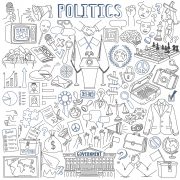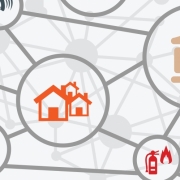In the USA, broad and deep government control is preferred to individual freedom of action; that control is continuously advancing and strengthening; and those who resist the control are met with coercive constraint. The productive class – everyone who doesn’t work for the government – becomes more and more repressed.
Let’s name some of the pathways down which government control keeps progressing (that’s their word for it: progressive) and then we’ll look at the barriers that are going to arise across those pathways.
1. Government spends more of your money each year and saddles you with more and more debt.
Economically speaking, government creates no value. It can only extract from value created by others. It does so via taxes and fees, and spend these on its own non-productive activities. Just to take the period of time this writer has been alive, from 1948 to 2016 (the last complete year of data), government’s officially reported spending progressed from approximately $55 billion to $6.67 trillion (or $6,675 billion). That’s 121 times, or 12,118%, or about 7% increase per year.
Not only does the government extract and spend your money, it racks up debt because it wants to spend more. We are all sadly familiar with the government debt total of about $20 trillion (which will probably inflate to over $23 trillion by the end of 2017).
2. Government adds new regulations every year.
Government control is implemented via the regulations it issues. These are not laws passed in Congress but rules formulated by bureaucrats in government departments, often referred to as the Administrative State. They are extra-constitutional but that doesn’t help us defend against them. Those who amuse themselves by counting the addition of administrative burdens on citizens in the Federal Register put the new load at about 24,000 new pages per year and about 3400 new final rules per year. You have no idea how many rules you are breaking, but you know these rules have a huge economic cost.
3. Government uses the central bank to monetize government debt and to control banks to create household and business debt.
The government will never repay the debt it has issued. That does not matter to the central bank that buys much of it. The central bank is the satanic issue of a joint venture between the government and the big US-based banks. The central bank prints money, and exchanges it with the government in return for government debt. It keeps interest rates low, so that the government can afford to make the coupon payments, but repatriates a lot of the coupon receipts to the US Treasury anyway. It’s all a shell game. In return, the member banks are authorized to issue household and business debt to the amount of 10 times the deposits they have on hand. It is this reckless credit creation that generates bubbles and then busts. No matter. The central bank bails out the member banks from their reckless behavior; only the working, taxpaying citizen suffers.
4. The government uses the central bank for inflation.
The central bank has an explicit 2% annual inflation target. That means they plan to make your income worth 2% each year. After 10 years of this, your paycheck will be worth about 80% of what it used to buy, and after 20 years, about 66%. Your wages don’t go up fast enough to compensate. It’s just another way of stealing from you.
5. The government has created the military-industrial-surveillance complex to exert further control.
The government spies on its own citizens. How evil is that? Do you want to live in a country where a small group of just over 2 million spy on the other 300+ million?
6. Government creates a massive welfare sector which it uses to buy votes.
The essence of the government scam is that the democratic process justifies their taxing and spending and debt accumulation. You voted for it, therefore it’s all done with your approval. Well, roughly 129 million votes were cast in the 2016 Presidential election, about 40% of the population. (Remember, all men are created equal, even those too young to be granted eligibility to vote.) So 60% of us didn’t vote for taxing and spending and debt accumulation. In fact, less than half of eligible voters turn out for House elections in many states.
More importantly, all the politicians, of whatever party, are willing, at whatever cost, to promise more and more expensive benefits to the voting population to try to get them to vote. This has resulted, over time, in the bloated, unaffordable, unsustainable welfare state. Half of US households receive benefits from one or more government programs. In fact, one way to look at government spending is that they bribe all of us. Tax subsidies, mortgage tax deductions, employer sponsored health insurance, tax-protected retirement plans, tax free municipal bonds – one way or another, we’re all taking the bribes. Which is, in effect, just the government allowing us to reclaim a small portion of the money they’ve already taken from us. Theft and bribery are their business.
7. Government employees get special compensation for sticking with them, rather than with us.
Total compensation for federal government workers has been estimated to be 17% higher than for comparable workers in the private sector. In the same study (published by the government itself) the cost of providing benefits for federal civilian workers was 47% higher than for comparable private sector employees. Cato Institute thinks the number is 78% more in total compensation for government employees compared to private sector employees.
Whichever is the most accurate number, you can be sure that, if you work in the private sector, you are heavily penalized.
8. There is no way out because the two political parties both support the taxing and spending and regulation, and merely trade power from time to time.
They tell us we can vote to change policies, but that’s hardly true. The Democratic and Republican parties stand for exactly the same things, and support exactly the same government policies. If spending and regulation and government debt grow every year, and central bank inflation compounds every year, how can the parties claim that swapping one for the other makes any difference at all?
Now for the optimistic countdown.
The happy news is that all of these pathways are approaching their terminal barriers. Peak government may be with us now, but the peak is followed by decline, which will mean a lesser load on citizens’ backs.
In quick countdown terms, here are the optimistic signals.
Government’s pension and healthcare promises are unsustainable.
They’ve promised more than they can deliver. They’ve miscalculated the costs. Their program will go bankrupt and fail. They’ll have to renegotiate them.
The government’s welfare promises are unsustainable.
When less than half the population is working to support more than half the population taking government benefits, you start to “run out of other people’s money”, as UK Prime Minister Margaret Thatcher famously said.
The population is beginning to find ways to evade the spying of the military-industrial-surveillance complex.
There is always a technology race between the good guys and the bad guys. The promising evidence is that the good guys – that would be us, the people who don’t work for the government – are finding some new tools. Blockchain technology offers secure, anonymous (or at least pseudonymous) exchange of assets, and may generate a successful private currency not issued by government fiat. It won’t be the case that government can’t regulate or intervene on the blockchain, but crypto can make spying, tracking and intervention very expensive, and it may at least force the government to narrow down their efforts to what is most important to them. Chances are our everyday business and personal trades will not fall into that category because it won’t generate significant revenue for an increasingly revenue-challenged regime.
Central banks are losing control.
Central banks have been printing money and creating credit at an unprecedented rate over the past several years. Their role has become one of monetizing government debt, debasing the currency (i.e. making the money in your pocket buy less each year), and inflating asset values – like houses and stocks. But there are signs that their ability to control outcomes in the way they want to is decreasing. Japan experienced a 10 year bust where the Central Bank could not generate asset value growth, GDP growth, employment growth, or inflation, despite their best efforts and best promises. The European Central Bank could not solve the political problem of one favored state (Germany) benefiting from the inflation, and others (France, Italy, Greece) suffering by comparison. The US Central Bank has created such as asset bubble in the stock market that it is bound to burst, which will cause financial system disruption and a loss of credibility for the bankers. Their years of hyper-experimentation might soon come to a disastrous end. When the financial system shows stress, the private sector creates new solutions.
Alternative financial arrangements will be decentralized and democratized.
Blockchain technology – better described as decentralized ledger technology – creates an alternative financial system that is not run on the central computers of big banks and financial institutions, but on hundreds of thousands of computers distributed all over the word. The software is used to create peer-to-peer exchanges of financial assets that are secure, fast and low cost – a much better experience for the customer, with which the big banks and institutions will not be able to compete. Fintech – new financial technologies – will create lots of alternative arrangements, some of which will succeed and some of which will fail, i.e. the market (you and me) will decide, not the government. Whatever the outcome, it will not be controlled by the centralized institutions, and they will not be able to keep up with the speed and creativity of decentralized innovation.
While we can’t evade government, we can secede.
It’s early days in regards to secession, but the movement is nascent and building. Sanctuary cities are declaring their determination to disobey federal laws. Institutions like the Tenth Amendment Center are bringing secession discussions to the fore. As Ronald Reagan said, we can vote with our feet. Secession discussions are a promising sign of vitality among the citizenry.
Prepare your individual response.
The individual acts as an entrepreneur in all aspect of his or her own life, bearing the uncertainty of the future by identifying opportunities and seizing them. It is unclear how peak government will descend into its post-peak phase. We all should think through our options, set our goals, identify our resources, choose our collaborators, and prepare to navigate a personal / family / neighborhood / community course. Navigation implies constant course correction as new data becomes available. Be flexible and thoughtful.













